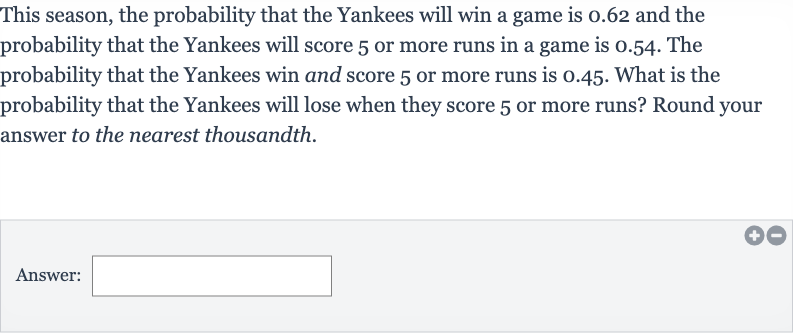AI tutor
Welcome to Bytelearn!
Let’s check out your problem:

This season, the probability that the Yankees will win a game is . and the probability that the Yankees will score or more runs in a game is . . The probability that the Yankees win and score or more runs is . . What is the probability that the Yankees will lose when they score or more runs? Round your answer to the nearest thousandth.Answer:
Full solution
Q. This season, the probability that the Yankees will win a game is . and the probability that the Yankees will score or more runs in a game is . . The probability that the Yankees win and score or more runs is . . What is the probability that the Yankees will lose when they score or more runs? Round your answer to the nearest thousandth.Answer:
- Events Denotation: Let's denote the events as follows:W: The Yankees win a game.R: The Yankees score or more runs in a game.We are given the following probabilities:
- Find Probability of Not Winning: We need to find the probability that the Yankees will lose when they score or more runs. This can be represented as , which is the probability of scoring or more runs and not winning. To find this, we first need to find the probability of not winning, which is .
- Check Independence of Events: Now, we can use the Multiplication Rule of Probability for independent events to find . However, we need to check if and not are independent. Since we are given , we can check for independence by comparing with . If they are equal, the events are independent; if not, they are dependent.Let's check:Since , which is not equal to , the events and are dependent.
- Calculate Probability of R and not W: Since and are dependent, we cannot simply multiply and to find . Instead, we need to use the given probabilities to find by subtracting from .
- Round Final Probability: Now that we have , we can round this probability to the nearest thousandth as requested.
More problems from Find probabilities using the addition rule
QuestionGet tutor help
QuestionGet tutor help
QuestionGet tutor help
QuestionGet tutor help
QuestionGet tutor help
QuestionGet tutor help
QuestionGet tutor help
QuestionGet tutor help
QuestionGet tutor help
